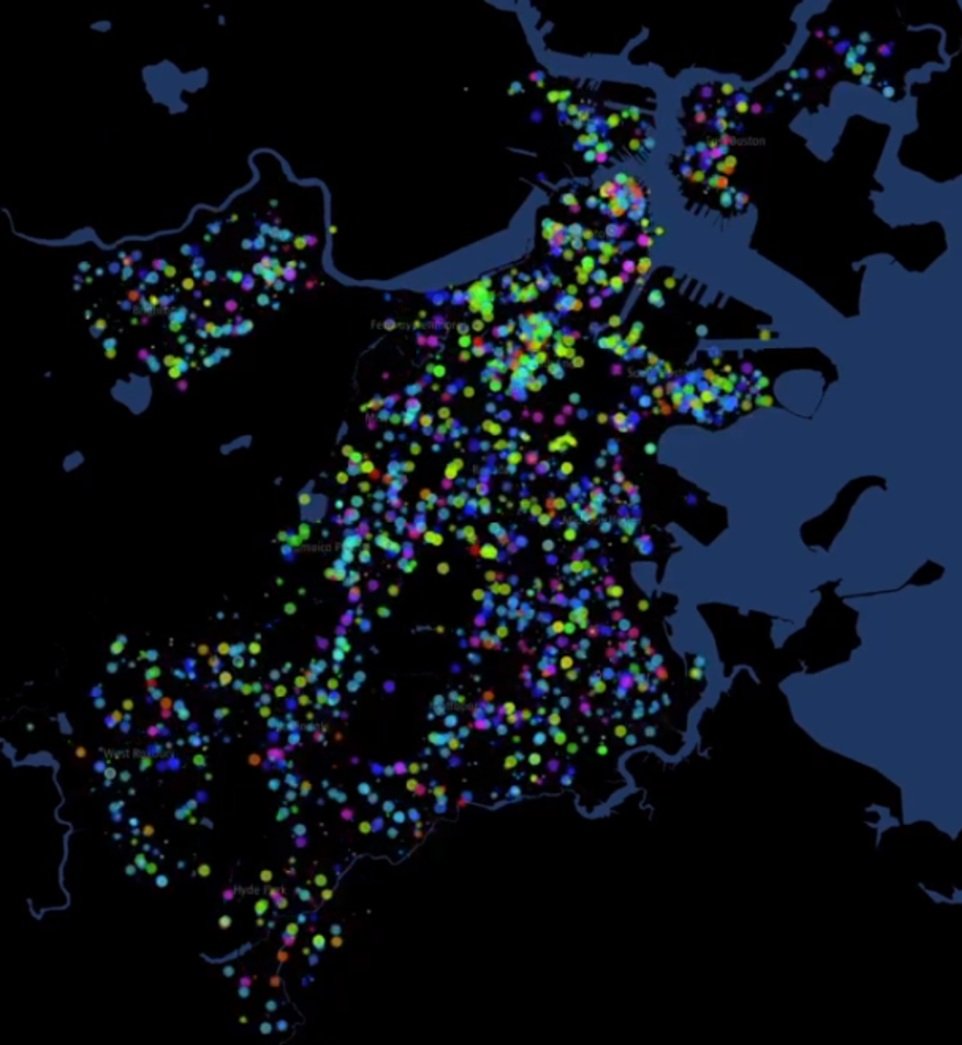“Seeing” Neighborhoods through Big Data
A New Lens on Communities
Requests for service received by Boston’s 311 system in October 2011, colored by services needed (e.g., fill pothole, remove graffiti).
Modern “big” or “naturally occurring” data from administrative and internet sources—including 311 and 911 calls, building permit applications, Tweets, Craigslist postings, and more—offer a detailed view of events and conditions across the city. Through the Boston Area Research Initiative (BARI) I have led and overseen a range of projects translating these novel data sources into measures of the physical and social characteristics of neighborhoods. This has generated measures of crime, civic engagement, medical emergencies, short-term rental density, restaurant quality, and more, all available through BARI’s Boston Data Portal. The work has been funded by the National Science Foundation, MacArthur Foundation, and Herman and Frieda K. Miller Foundation. I recently received a grant in collaboration with the MIT Social Dynamics Lab to convert cellphone mobility data into measures of economic development, climate resilience, and segregation that are accessible to community stakeholders.
Publications (students in bold)
Ristea, A., Tucker, R., You, S., Amiri, M., Beauchamp, N., Castro, E., Chen, Q., Ciomek, A., Das, B. de Benedictis-Kessner, J., Gibbons, S., Hangen, F., Montgomery, B., Papadopoulos, P., Robinson, C., Sheini, S., Shields, M., Shu, X., Wood, M., Heydari, B., O’Brien, D.T.* A Multisource Database Tracking the Impact of the COVID-19 Pandemic on the Communities of Boston, MA, USA. In press at Nature Scientific Data.
Ke, L., O’Brien, D.T., Heydari, B. 2021. Airbnb and neighborhood crime: The incursion of tourists or the erosion of local social dynamics? Public Library of Science. 16: e0253315.
Tucker, R., O'Brien, D.T., Ciomek, A., Castro, E., Wang, Q., Phillips, N.E. 2021. Who 'tweets' where and when, and how does it help understand crime rates at places? Measuring the presence of tourists and commuters in ambient populations. Journal of Quantitative Criminology. 37: 333-359.
O’Brien, D.T., Sampson, R.J., Winship, C. 2015. Ecometrics in the age of big data: Measuring and assessing “broken windows” using administrative records. Sociological Methodology, 45: 101-147.
O’Brien, D.T., Montgomery, B. 2015. The other side of the broken window: A methodology that translates building permits into an ecometric of investment by community members. American Journal of Community Psychology, 55: 25-36.
Grants
National Science Foundation program on “Human Networks and Data Science-Infrastructure.” Support for a proposal titled “Mobility Data for Communities (MD4C): Using Cell-Phone Records to Study Human Societal Dynamics.” $935,000 (collaborative grant, Northeastern University portion, $500,000). 2023-2025. PI, with Nigel Jacob, Sandy Pentland (MIT).
National Science Foundation program on “Resource Implementations on Data-Intensive Research.” Support for a proposal titled “Portal to Data and Analysis Tools (P—>DAT): Enabling Data-Intensive Research in the Urban Sciences on Linked, Large-Scale Records.” $685,000 (collaborative grant, Northeastern University portion, $154,548). 2017-2018. PI, with Robert J. Sampson, Christopher Winship, Mario Luis Small, David Lazer, Marta Gonzalez.
John D. and Catherine T. MacArthur Foundation. Support for a proposal titled, "Boston Area Research Initiative: Extending the New Urban Science.” $200,000. 2016-2017. PI, with Robert J. Sampson
